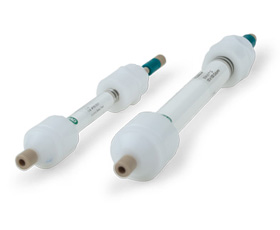HPLC Column Principles
The physical properties of the target molecules (analytes) determine the most suitable HPLC column for a given separation. The molecular characteristics that impact HPLC column selection include hydrophobicity/hydrophilicity, intermolecular forces (particularly dipole-dipole), intramolecular forces (ionic), and size. HPLC column separations can often exploit multiple differences in the molecular properties of the target molecules. Generally, the structure and chemistry of the HPLC column packing (stationary phase) determines the analyte elution profile.
HPLC column sizes range from capillary to process scale. The internal diameter (ID) and volume of a column determine both how much sample can be loaded onto a column and the sensitivity of separation. The column ID can affect the separation profile, particularly when using gradient elution, with smaller IDs yielding increased separation and detection sensitivity. Therefore, for analytical separations there is typically a trade-off between sensitivity and the sample volume loaded onto a column.
HPLC Column Packings
Many of the types of packing used for gravity or low-pressure chromatography are not able to withstand the high pressures used in an HPLC system. Common packing materials in HPLC columns include silica or hydroxyapatite media and polymeric resins such as polystyrene divinylbenzene.
The use of smaller-diameter beads generally results in improved separation sensitivity due to the increased surface area. However, column pressure increases as bead diameter is reduced for a given flow rate, placing a practical lower limit on bead size. Media bead diameters are typically in the range of 1.8–5 μm for an analytical HPLC column.
Early HPLC columns were packed with irregularly shaped silica particles to increase surface area. Currently, spherical porous silica has replaced irregular silica for most uses. The spherical shape provides increased efficiency and lower backpressure, and the porosity increases the surface area. Polymeric resins are highly cross-linked and are particularly useful for separations where the pH is outside the operating range of silica packing.
HPLC Column Types
A wide variety of HPLC column types are now available for various analytical applications. A few of the most commonly used types are described below, classified by separation mechanism.
Ion exchange HPLC columns have charged packing. An ion exchange column can be either cationic or anionic. This type of HPLC column separates polar molecules based on their charge. The mobile phase is an aqueous buffer. Ion exchange HPLC columns can be used to separate many types of analytes and are commonly used for separations of carbohydrates, amino acids, and proteins.
Ion exchange and ligand exchange chromatography may be combined in a column. In these combined-mode columns, ion exchange is usually via metal ions, and the ligands are electron-donor molecules such as hydroxyl groups or amines. This type of HPLC column is frequently used for the separation of monosaccharides.
Reversed-phase HPLC columns have nonpolar packing. They are used with aqueous and water-miscible organic solvent mobile phases. The most common solvents are acetonitrile, methanol, and tetrahydrofuran (THF). Both isocratic (constant concentration) and gradient (increasing organic solvent concentration) elution are used with reversed-phase columns. Selectivity and retention times are dependent on a number of parameters including the pH of the mobile phase. The reversed-phase HPLC column is the most versatile and commonly used column type and can be used for a wide range of different types of analytes.
Normal-phase HPLC columns have polar packing. The mobile phase is nonpolar and therefore usually an organic solvent such as hexane or methylene chloride. This type of HPLC column includes a type of partition chromatography using hydrophilic interaction liquid chromatography (HILC), in which the mobile phase contains a low concentration of water. In an ion-moderated partition HPLC column, the addition of ionic compounds such as ammonium acetate to the mobile phase can both change the retention times of analytes and increase their polarity. This class of HPLC column is used for small molecules such as organic acids, some drugs, and a range of biomolecules including glycosylated proteins.
Size exclusion HPLC columns do not rely on the interaction of the analytes with the column packing but rather utilize a sieving effect based on molecular weight. The packing contains both mesopores and micropores. The size distribution of the pores determines the size of molecules in the sample that can diffuse into the pores. The extent to which molecules can diffuse into the pores determines the retention time and elution profile. Molecules that are too large to enter the pores pass through the column rapidly, eluting as a single peak after the void volume. Size exclusion HPLC columns are used primarily for the separation of proteins and carbohydrates.
Other types of HPLC columns include affinity, ion exclusion, and displacement chromatography columns; a chiral HPLC column can be used to resolve racemic mixtures.




